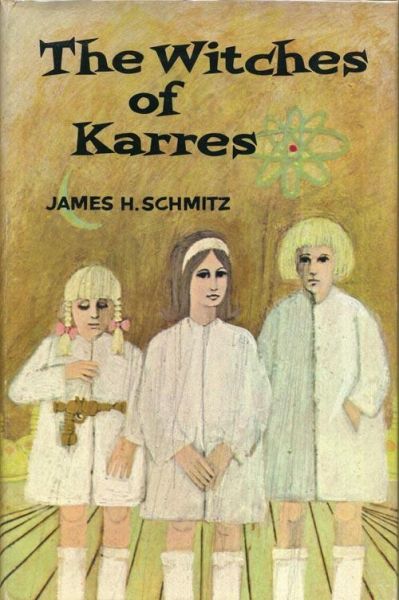Dark Is Bright As Fire
The Witches of Karres
By James H. Schmitz

17 Dec, 2017
1966’s The Witches of Karres is James H. Schmitz’s novel-length expansion of his 1949 novelette of the same name. It is a standalone space opera.
Given an aged starship and a cargo of dubious value, naive Captain Pausert headed out into space in search of a fortune and his prospective father-in-law’s respect. If he had not also been hobbled by his own essential decency, he might have realized his dreams.
At a stop on the planet Porlumma, Pausert acquires three young slaves — twelve-year-old Maleen, nine-ish Goth, and kindergarten-age the Leewit. The former owners are curiously eager to relinquish ownership of their slaves, an oddity about which Pausert is not nearly as curious as he should have been, focused as he is on the need to rescue the girls from their owners. When it is too late, he discovers he has rescued a trio of psionic adepts, all of whom are eager to use their powers to repay Pausert in ways that can only bring him official opprobrium.
Pausert zips off to the girls’ home world, Karres, to return them to their family. That should have been the end of that … but when he returns to his homeworld of Nikkeldepain, Pausert discovers that Karres is pariah planet. Anyone in any way associated with Karres becomes a pariah. Pausert also finds that he has become a wanted criminal.
No worries. Goth has stowed away aboard his spaceship and helps him escape from Nikkeldepain. She can use her psionic powers to create a Sheewash Drive, one that is faster than anything else in space.
Now he has a fast ship full of cargo that, while not precisely licit1, is valuable, no debts that he plans to acknowledge„ and a witchy sidekick (and fiancée, if Goth has anything to say about it). Say ho! for a life of adventure!
Goth’s ability to wield the Sheewash drive2 makes the life of adventure a little too adventurous. There are many entities, from the official (the Emperor himself) to the criminal (pirate warrens in deepest space) who would dearly love to get their hands on the Sheewash Drive. They will stop at nothing — kidnapping and torture, hijacking and murder — to grab it.
If that were not enough, Pausert finds himself on a collision course with the worst of the eldritch horrors that infest space.
~oOo~
Some readers may wonder that I call this standalone. It’s because sequels written by third parties long after the author was too dead to consent don’t count. If you have some muddled and entirely incorrect reason for thinking I am wrong on this point, feel free to share your misapprehensions in the comments.
Some readers may be a bit surprised at the offhand mentions of slavery. Just another facet of the Imperial way of life, nothing to see here, move along now. But perhaps we should consider that when this novel first came out, the US was less than a century past legal chattel slavery and was still mired in the thinly disguised version of slavery known as Jim Crow. Moreover, the original story was published in Analog, whose editor at the time was an advocate of slavery. It is to the credit of the author that Pausert himself does not seem all that keen on the institution.
Other readers may be distracted by the fact that Pausert’s future wife still has most of her baby-teeth when she teams up with him. If she lived in Canada she would not be old enough to drive for another seven or so years (much less helm starships3). In Pausert’s defence, he doesn’t take her declaration that she plans to marry him all that seriously. His relationship with Goth is as sexless as one might wish; he’s just other Analog protagonist kept squeaky clean by Kay Tarrant’s keen eye for anything remotely scandalous.
Though it seems that the adults on Karres take Goth’s intentions seriously. So (apparently) does the novel itself. One wonders why the author thought that making his protagonist’s love interest nine years old was a good idea. It’s not like there’s any aspect of the plot that depends on her being nine or ten.
Some of you may want to point out that Goth might have been as old as ten, to which I say “the Piers Anthony books are over that way.”
On the gripping hand, the book’s views on the subject of February-December romances are no more peculiar than those of a horrifyingly large fraction of white Alabamans.

This novel also illustrates one of the hazards of expanding popular short works to novel length. Sometimes there just isn’t enough story to support a longer version. Once the original story is over, the novel becomes increasingly repetitious. Also dependent on coincidence, convenient manifestations of psionic powers, and the timely intervention of godlike beings. It all ends up feeling rather contrived.
On the plus side, Schmitz seems to have rejected (for the most part) the limited views of female potential held by too many of his contemporaries. Pausert’s insipid and unfaithful Nikkeldepainian fiancée aside4, most of the women in the novel, child or adult, show agency and intelligence. Some are outright villains, some are secret agents of the Empire itself, but they pursue their agendas competently. The most hapless character in the book is Pausert himself.
The original story

1: Not narcotics, you zwilnicks. Goods like furs and food that are proscribed for fear that they may carry invasive species. It is probably best not to wonder if the goods in question were in fact contaminated and if Pausert left a trail of worlds in ecological collapse behind him.
2. When first mentioned, the Sheewash drive is said to propel a spaceship at a fantastic speed of five light-years per hour. Later evidence suggests that its speed is only limited by the demands of the plot.
3: I assume. I notice the requirements and conditions of employment for (Canadian) astronauts don’t seem to specify age…
4: Actually, even his original fiancée, the woman who dumps him, is competent. She ends up married to a rich, well-connected man, which is what she wanted in the first place. She may have been wise to jettison a beau who is a wanted criminal when last she sees him.
